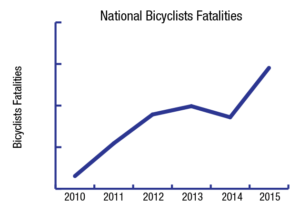The Georgetown University Student Association and university administration are planning a series of new initiatives to make the university’s campus and surrounding areas friendlier to bicycle riders, including distributing free helmets to riders and creating a bicycle lane next to the Georgetown University MedStar Hospital.
GUSA has been collaborating with the designers of the new wing of the Georgetown University MedStar Hospital and the administration to integrate an exclusive lane for bicycles next to the green space that will be located outside the building. A bike lane is now included in the preliminary plan for the site, according to GUSA Vice President for Transportation Policy Jack Pelose (COL ’19).

While cyclist deaths have increased nationwide over the last five years, Washington, D.C., remains an outlier in total number of deaths as a result of traffic accidents involving cyclists. Georgetown seeks to expand its biker-friendly initiatives in coming months.
“We believe that a bike path in north campus would be a valuable addition to Georgetown because it would separate bike traffic from pedestrian traffic, improving safety for both groups, and encourage biking in the Georgetown community,” Pelose wrote in an email to The Hoya.
To further promote bike safety, the Georgetown Office of Sustainability has partnered with Coca-Cola to distribute 500 bike helmets this academic year, according to Sustainability Programs Coordinator Greg Miller (SFS ’14).
Additionally, GUWellness will sponsor a “Bike Commuting 101” class every month to teach commuters how to get around Washington, D.C.
Despite being recognized by the League of American Bicyclists as a Bronze-level Bicycle Friendly University since 2013, the university can still improve accessibility and safety for bicycle riders, according to Pelose.
“There are things we can improve with biking. I think that the Georgetown neighborhood is hard because a lot of it is brick and stone, which is hard to bike around, and there’s not a lot of good ways lining our sidewalks for bikes on-campus or in the neighborhood at all,” Pelose said.
The D.C. metropolitan area has been an outlier in the national trend of rising yearly bicycle crash fatalities, according to a report this August by the Governor’s Highway Safety Association, using data from 1994 and 2015.
According to an email from the Washington Metropolitan Police Department, bicycle crash fatalities in Washington, D.C. have oscillated between one and two accidents per year in the last five years.
Pelose and Miller said the Georgetown neighborhood is relatively safe due to the prevalence of small roads that force drivers to slow down, but they also acknowledged that cobblestone streets and the intersection of M Street and Wisconsin Avenue are potentially dangerous.
The administration studied these roads and their usage in 2016 as part of the planning for the long-term campus development plan.
“We don’t have bicycle crash fatality data for the Georgetown neighborhood in particular, but as part of the campus plan process in 2016, Georgetown did do an exhaustive study about transportation in the Georgetown neighborhood,” Pelose said.
According to Pelose, the university tracked the number of cars and bikes at various intersections around the neighborhood in order to determine where the two are most likely to intersect.
Vice President of Facilities Management Robin Morey wrote in an email statement to the Georgetown community that the university has integrated this information into the master plan and aims to achieve a Silver designation as a Bicycle Friendly University this year.
“The University’s master plan also emphasizes pedestrian and bicycle-friendly development over the next 20 years,” Morey wrote.
In 2015, the administration declared the campus a “pedestrian core,” limiting speed limits on campus to 15 miles per hour and integrating mechanisms like speed bumps to slow traffic, according to Morey.
Georgetown University Police Department Chief of Police Jay Gruber recommends that riders also take responsibility for their own safety.
“Riding a bicycle in an urban environment takes full-time attention and adherence to all traffic laws,” Gruber wrote in an email to The Hoya. “In addition to wearing helmets, riders should obey traffic laws and should never wear headphones or earbuds while riding.”




















